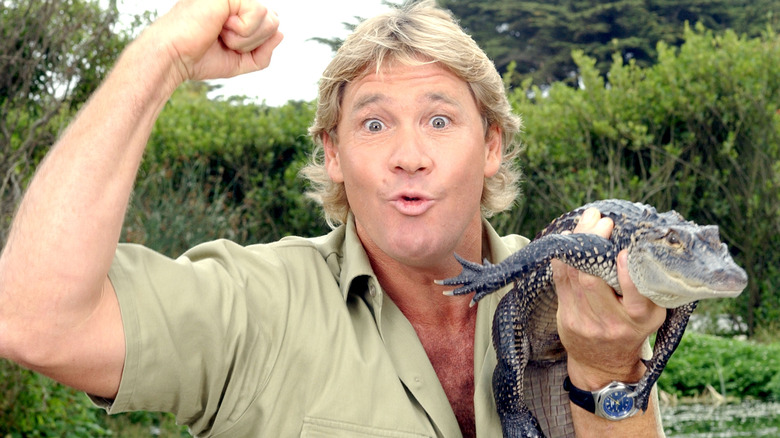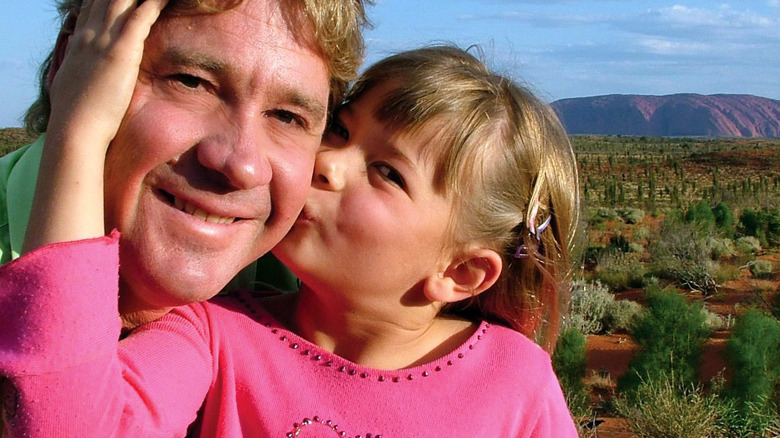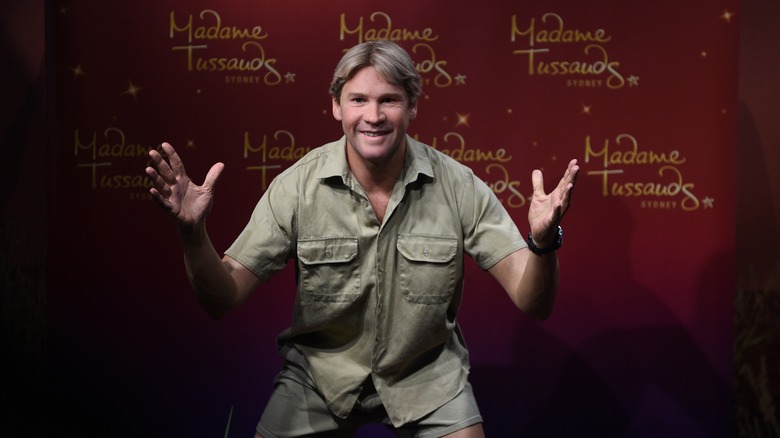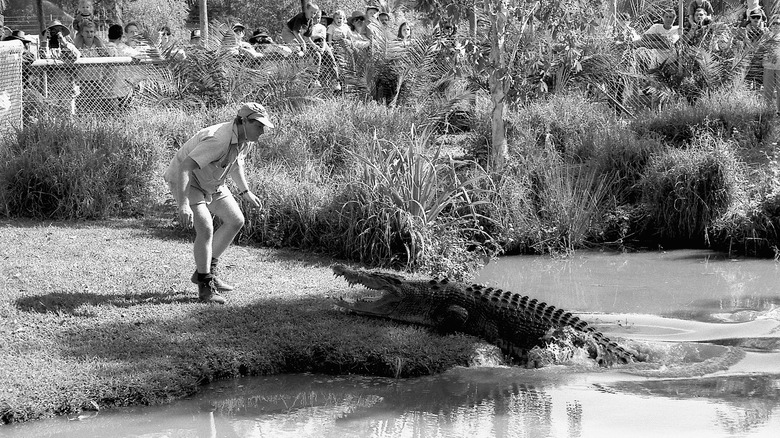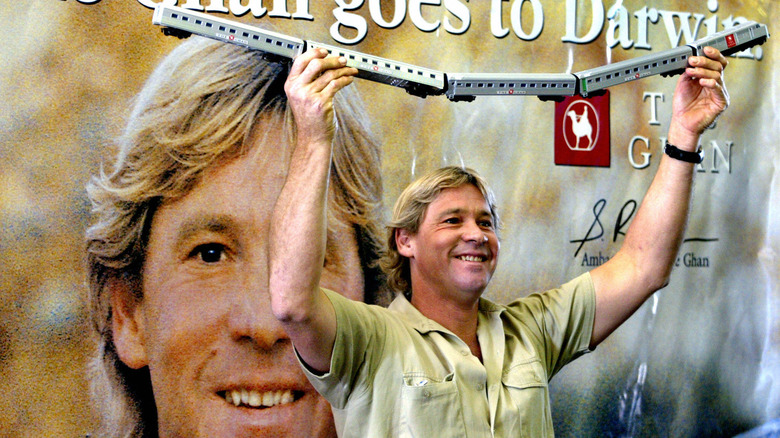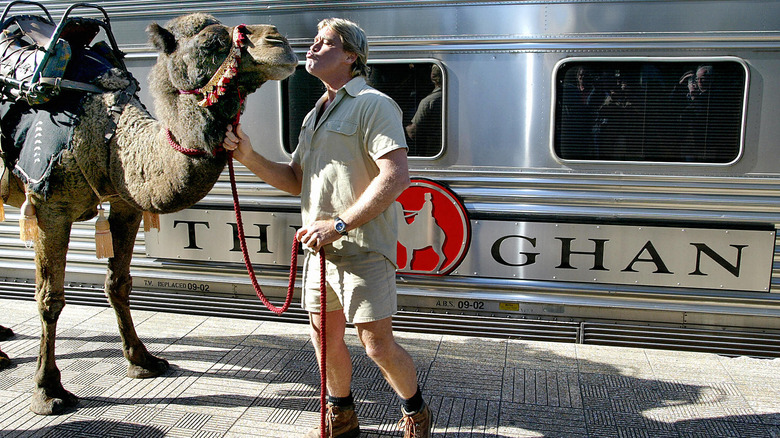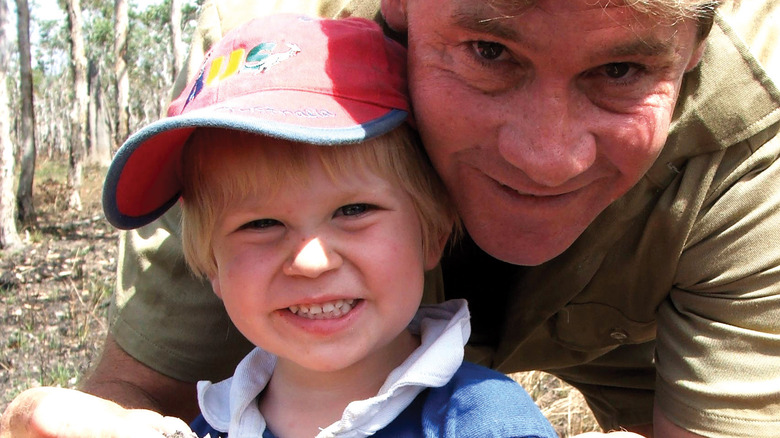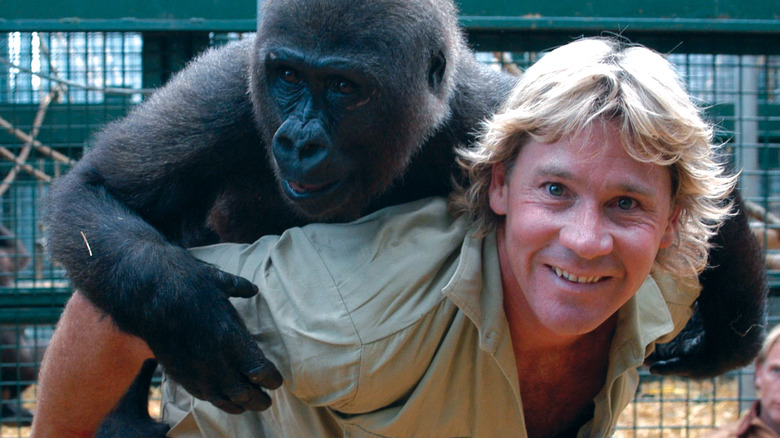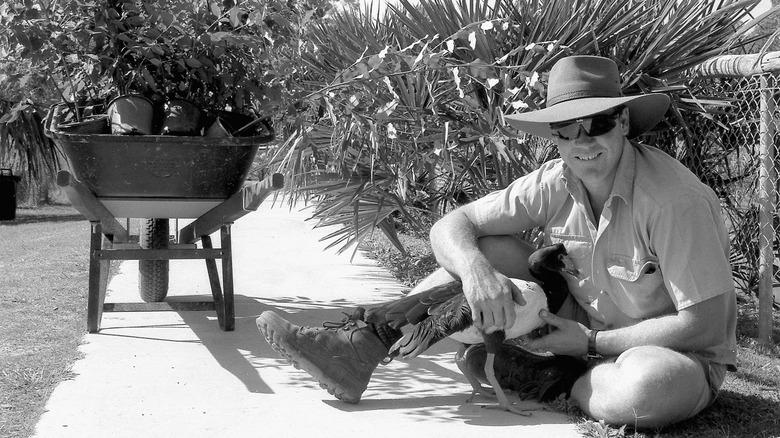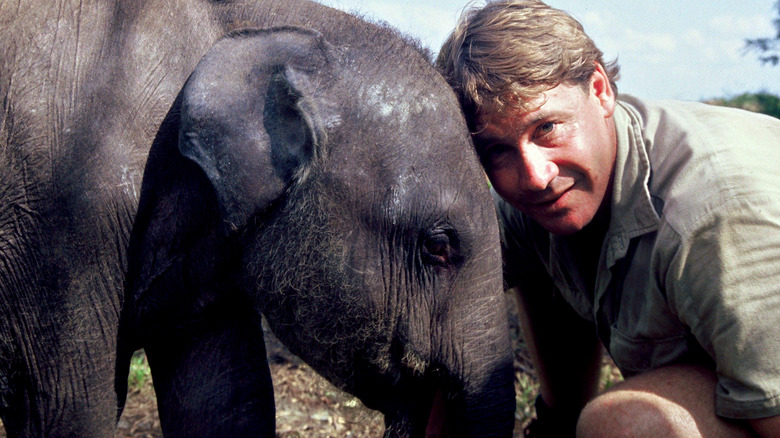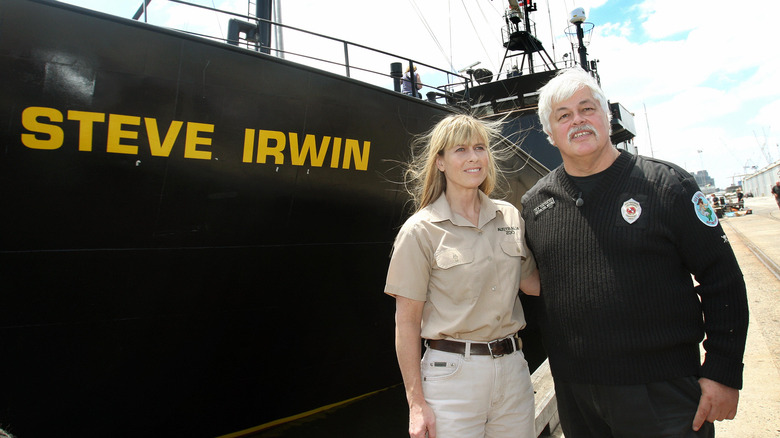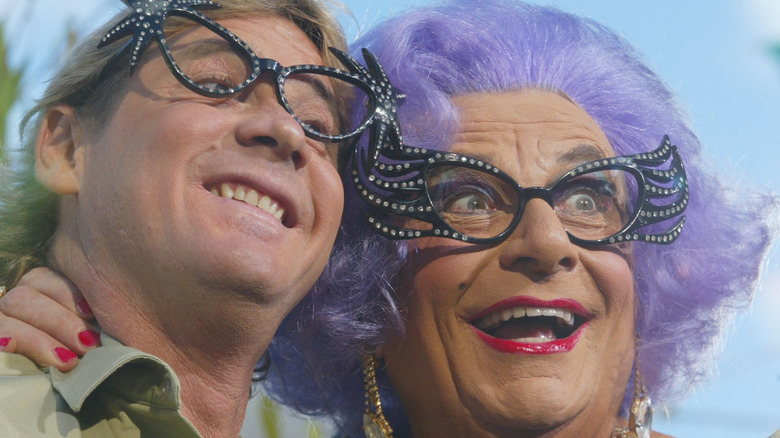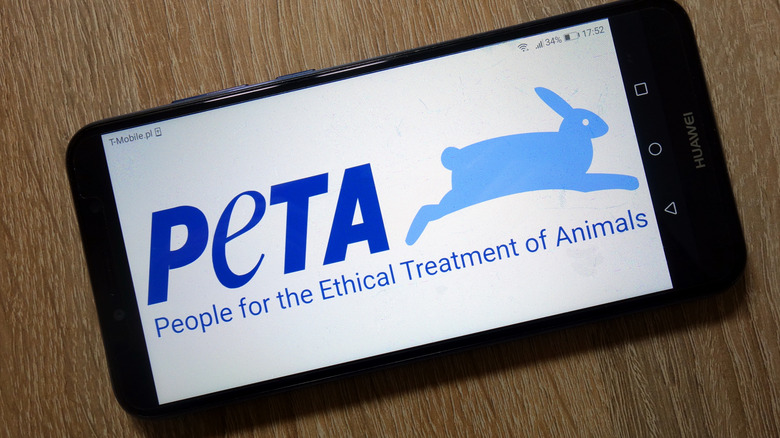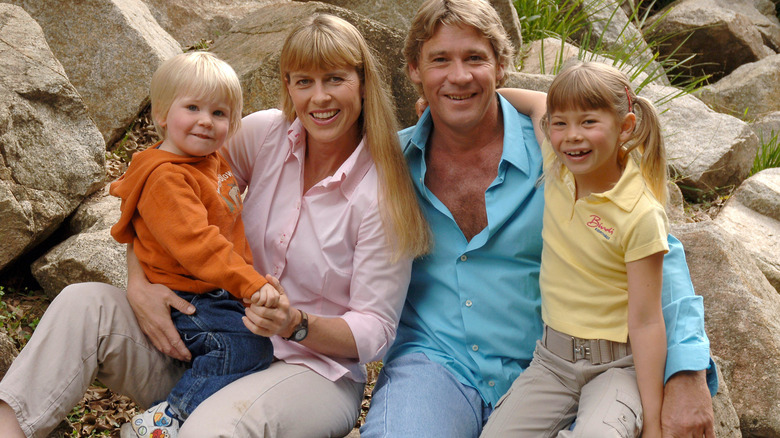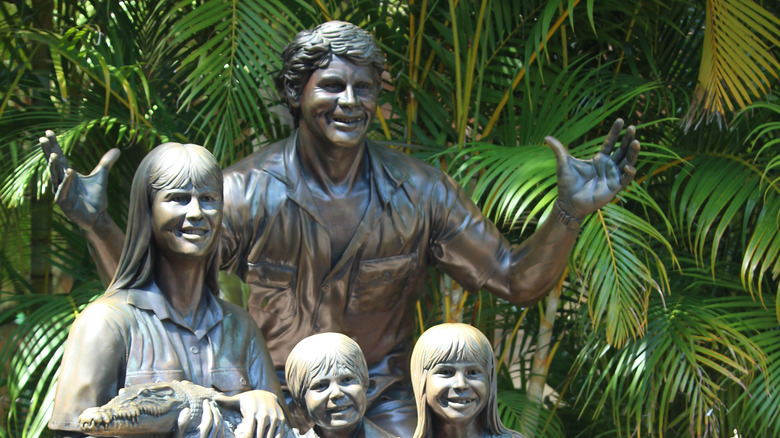Steve Irwin: What Only True Fans Know About The One And Only Crocodile Hunter
Crikey! Love him or hate him, an entire generation was introduced to some of the coolest creatures from Down Under and around the world by the ever-enthusiastic Steve Irwin. Irwin was probably happiest when he was in a situation that would make most people soil themselves in fear. You need some serious adrenaline and a touch of wild to do the things he did.
The world knew him as the Crocodile Hunter, but it was the kind of hunting most animal lovers could get behind. He hunted for fun stories, preaching education and conservation, understanding some of the deadliest creatures in the world, and respect. It all ended far too early in 2006 when the world's animals lost one of their biggest cheerleaders to a tragic underwater accident involving a stingray. However, his work, his family, and his legacy are all still making a difference long after Irwin's death. Let's take a look at the man inside the khakis.
He was working with very dangerous animals by age 6
The usual disclaimer is that people shouldn't try things at home unless they're a professional, and Irwin had some serious cred. According to his obituary in The Guardian, he kicked off his snake-handling career in earnest at the tender age of 6, when he was given a 12-foot scrub python as a pet. (All those stories you've heard about Australia might not be so exaggerated after all.)
He named his pet snake Fred, and according to what he told Reptiles Magazine, he'd been catching snakes for a few years by then. "When I was very young, like 4 years of age, I captured my first brown snake by putting my foot on it," he said. "Dad came over and decked me out of the way — it's the second most venomous snake in the world." Five years later, he jumped on the back of his first crocodile at age 9, under his father's watchful eye. You might be wondering how watchful that eye actually was, but hey, he made it to adulthood.
He discovered a butt-breathing turtle that bears his name
In 1990, Steve Irwin and his father did what's possibly the coolest father-son bonding activity in the world: They discovered a new species. It's a freshwater snapping turtle aptly called Irwin's turtle or Elseya irwini, and they found it in an area of Australia called Urannah. According to Urannah's official site, the turtle's a bit of an odd duck. The official scientific term for it is a cloacal respirator, and in layman's terms, it's a butt-breather. Fortunately, it's also adorable and has a brilliant personality, so we can overlook the fact that it does, in fact, breathe through the butt.
It's also an example of a species that's not yet listed as endangered but could very well be in the future. Even though there are thousands of individuals still found in their natural habitat, there's a proportionately greater number of adult females compared to males or juveniles. That doesn't bode well for the species, making this little fella a prime example of just how important it is to start conservation work before an animal becomes critically endangered. Fortunately, that's exactly what Queensland's Department of Environment and Heritage Protection is doing.
He wrestled a croc that was eating his friend
Steve Irwin had a ton of close calls, but it was Larry King who got him talking about the biggest and scariest. It sounds like an awful horror movie trope of some sort, and Irwin said it involved saving his best friend of years, Wes, and a massive crocodile named Graham. Graham, he said, had already bitten him once when he and Wes were tasked with shoring up his enclosure during a flood. Graham was having none of that — mostly because he was sharing the enclosure with another croc named Bindi and their nest.
"Graham snuck up on Wes, grabbed him right by the bottom, and just started killing him right in front of me, tore two pieces of meat the size of my fist right out of his bottom, right out of here which was kind of lucky, because if it had hit bone, when crocs bite, it hits bone mate, the bones explodes."
Irwin said he hopped on the croc, grabbed his back leg, and twisted. Graham dropped his friend and they headed right to the hospital, where they got him stitched up and put back together. Oh, and Graham? They almost lost him, too, to food poisoning. You just can't make this stuff up.
His death really was a freak accident
Irwin spent his entire life working with and rescuing a stunning number of dangerous animals in the world, so when he was killed by a stingray, the world's collective response was, "Seriously?" The media called it a freak accident, but just how freaky was it? Well, really freaky. According to Slate, there aren't solid numbers on how many people have actually been killed by stingrays, but estimates range between 17 and 30 incidents worldwide. Not per year; there are 17 to 30 stingray deaths that have been recorded by humans. (There have probably been a few more deaths, but they aren't tracked well.) The Atlantic says he was the first Australian to have a deadly encounter with a stingray in 60 years.
ScienceLine took a look at how dangerous stingrays actually are. The first issue is they're massive — up to 14 feet long and weighing in at a whopping 750 pounds. Yes, they're venomous, but they're usually not hostile. There are around 1,500 stingray-related incidents every year just in the U.S., but most are just painful, not lethal. And most stingrays are much smaller than the one that killed Irwin. Still, unless you're trained and well-practiced, you should probably give venomous creatures a wide berth.
His cameraman broke his silence about what really happened
When news of Irwin's death broke in 2006, it seemed like it couldn't be true. While he always seemed insane, he also seemed completely untouchable, and his rapport with animals made his death seem that much more bizarre. There was footage because Irwin and his crew were filming a documentary about the Great Barrier Reef when it happened. But that footage was given to Irwin's wife Terri, and never broadcast. It was shot by cameraman Justin Lyons, and in 2014, he revealed what happened.
Lyons (via The Telegraph) said they had come across a giant stingray, somewhere around 8 feet across. They were trying to get a shot of the stingray swimming away from Irwin, but it lashed out at him instead. Lyons said he hadn't even realized anything was wrong at first, as he'd been following the stingray with the camera. When he looked back at Irwin there was blood in the water, and that's when they saw the hole in his chest. Reports that he had pulled a barb out — an action that resulted in his death — were wrong, Lyons said, and added that his last words were simply, "I'm dying."
Irwin's father spoke up later, criticizing Lyons (via The Independent) for going public and re-opening old wounds. "For a lot of people trying to get on with their lives without Steve, it wasn't something that helped by any means."
He was very aware Australians saw him as a caricature
Steve Irwin wasn't one to shy away from controversy, but it was the way he did it that some Australians took issue with. According to The Guardian, some of his fellow countrymen viewed his untimely death with the same shock and grief as those who mourned Princess Diana, but some Australians thought Irwin was less of a crusader and more of a stereotype. At the same time, he was the embodiment of the world's opinions about Australia: down-to-earth, capable of surviving in the wildest terrain, and a fan of saying words like "crikey" and "g'day." He was so over the top that some struggled to distance themselves from the stereotype.
He knew it, too. After his death, Australian Broadcasting Corporation quoted him as once saying, "And yet back here in my own country, some people find me a bit embarrassing. ... You know, there's this ... they kind of cringe, you know. ... Is it a cultural cringe? Is it, they actually see a little bit of themselves when they see me, and they find that a little embarrassing?"
He did some serious work off-camera
With all his over-the-top enthusiasm and stereotypical Australianisms, it was easy to see Steve Irwin as a showman who was just out to get attention. Even within the wildlife conservation and education community, he was hugely polarizing, but what viewers didn't see was the work he did off-camera. That includes things like a partnership with researchers from the University of Queensland, where he helped trap and tag crocodiles so their movements could be monitored. That program has learned some pretty awesome things about crocodiles, the Smithsonian Magazine says, like just how far their territories reach, how deep they can dive, and how they actually live in groups with a defined — but complicated — social hierarchy.
In 2004, Irwin and the university launched a new program, awesomely called Crocs in Space. The program outfitted saltwater crocodiles with remote trackers that were monitored from satellites, and scientists have learned some pretty awesome stuff from these programs Irwin supported and helped fund. Did you know a non-dominant male crocodile will travel hundreds of miles? That they can hold their breath for around seven hours? They're ridiculously cool animals, and we didn't know any of this before Irwin and his family got involved.
As noted by Scientific American, he also had a plan to save endangered animals he called a time capsule, in which at-risk animals would be housed and rehabilitated in zoos until they were ready to be reintroduced into the wild.
He helped save a diver's life
After Steve Irwin's death in 2006, global media picked up and ran with a slew of tributes. An American diver named Scott Jones has probably the most incredible story, and he told it to The Sydney Morning Herald.
In 2003, Jones was diving off the coast of Mexico with a small group when they were caught in a sea surge. Jones and a fellow diver, Katie Vrooman, were battered against the rocks. Jones clung on in a desperate attempt to survive and even tried to resuscitate Vrooman, but he failed and was forced to let her body go. After that, he climbed onto the rocks and settled in for the night.
Irwin and his crew were nearby and picked up the distress call. They were filming a documentary but halted production to join in the rescue effort, and it ended up being Irwin himself who found the stranded diver and hit the water to swim out to help him to safety. "We'd love to go to Australia and tell his wife and kids just what a great man he is," Jones said. "He was a hell of an educator, from kids all the way up to old farts like me. ... He was a hero."
He refused to go vegetarian
Sure, his methods were controversial sometimes, but you can't argue about whether his heart was in the right place. That's what makes it sort of strange that Steve Irwin outright refused to become a vegetarian. Sounds odd, at a glance, but listen to his reason.
"In no uncertain terms did I research it," he told Scientific American, right before saying it just wasn't feasible. He gave the example of a cow, a cow that would keep him supplied with a belly full of nutritious meat for a month. While the cow was being raised, she could share her little patch of paradise with trees, plants, and other little critters, while the land around her could be home to all kinds of other animals. If he was a vegetarian, he'd need a heck of a lot more land dedicated to only feeding him. "Nothing else can grow there," he adds. "Herein lies our problem. If we level that much land to grow rice and whatever, then no other animal could live there except for some insect pest species. Which is very unfortunate." And ... it totally makes sense, so next time you carnivores get into an argument with a vegetarian, Irwin has you covered.
He condemned the idea of 'sustainable use' as conservation
The idea of sustainable use conservation is one that's championed by the International Union for Conservation of Nature, and it's basically promoting the idea of a balance between using various wildlife species and ensuring their survival. Steve Irwin had pretty strong feelings on just how bad this idea was, and condemned it when Scientific American asked him about his feelings on the possibility of sustainable ivory trade in Zimbabwe.
The theory was that villagers would be more likely to protect elephants if they were allowed to harvest their ivory in a way that didn't destroy the entire population. Irwin called it "the greatest propaganda in wildlife conservation at the moment," claiming it had been started and promoted by people who wanted to make easy money off animals in a way that would make them look like the good guys. Harvested products like big cat skins, crocodile skins, and ivory are products mankind just doesn't need to survive, he said, meaning there's no real reason to kill for them.
"We've already got cows, chickens, turkey, ducks, sheep," he said. "We've already got domestic animals, we don't need to kill and eat our wildlife or wear it. I will die fighting sustainable use because I believe it's propaganda, and I'd like to see it stopped."
He'd dress in disguise to walk around the zoo
Fame is sometimes fickle. For all the benefits it can provide, it comes at the price of a loss of privacy and anonymity. At a certain level of fame, you can hardly go anywhere without being recognized. Even someone as gregarious as Steve Irwin might want to slip under the radar once in a while. And it seems he found a way to do that.
In an interview with The Daily Telegraph promoting a fashion shoot for Stellar magazine, Robert Irwin — who was not yet 3 when his father Steve Irwin passed — shared a story he'd been told about his dad. Finding the level of attention in the United States excessive, he navigated crowds with an alternate persona. "He had an alter ego called Glenn Glamour," his son said. "He would put in false teeth, a wig, this ridiculous multicolored trench coat, the weirdest pants and really sketchy sneakers."
As ridiculous as the disguise may sound, it worked. Robert Irwin suspects that the sheer oddity of the outfit kept people from recognizing who was wearing it. It's something he's observed in his own life, albeit in a less ostentatious way; as a dabbler in fashion, Robert Irwin reports that his dressier clothes keep people from telling who he is.
Steve Irwin vs PETA
PETA has never been shy about picking fights, even with other organizations dedicated to conservation or animal rights. In fact, PETA once published an article on its site rejecting the term "conservation." The organization keeps a list of environmental organizations they find objectionable — a list that includes such prominent names as the Sierra Club — and despite using celebrities in its own promotional material, it's gone after the likes of Zac Efron for appearing in eco-minded ads they disapprove of (via PETA).
The organization was particularly disapproving of Steve Irwin and his methods. An article on their site accuses Irwin and other celebrity conservationists of putting their egos before their core message of environmental protection, and of traumatizing animals with publicity stunts. In 2019, they singled out Irwin for criticism, taking to Twitter to complain when Google featured the late zookeeper in its Google Doodle on his birthday.
PETA claimed that Irwin was "harassing" the stingray that killed him and that he took infant animals from their mothers to exhibit before the public. But judging from the reaction the tweet received, PETA's case wasn't exactly persuasive. USA Today reported widespread condemnation of the remarks across social media, with several reactions highlighting Irwin's educational and conservational work as a challenge to the picture PETA painted.
How Steve met Terri
In his live shows, talk show appearances, and adventures in "The Crocodile Hunter," Steve Irwin was often accompanied by his wife Terri Raines, who endured all the same dangers and preached the same message of conservation. Raines was no stranger to animal care prior to marrying Irwin. According to her biography page with the Australia Zoo, her father cared for animals injured on the roadside and she worked with veterinary and wildlife rehabilitation organizations as a young woman. But falling in with Irwin took her work with animals to a new level.
In an episode of "The Crocodile Hunter," Raines and Irwin shared the story of how they met. Raines was visiting the Australia Zoo (then called the Queensland Reptile and Fauna Park) as a tourist in 1991 when she happened to catch a live crocodile feeding conducted by Irwin. Raines was struck by Irwin's enthusiasm and nerve — and sex appeal, as she added in an interview with Oprah. Irwin, for his part, declared that he fell in love with Raines at first sight. She held back after the show to talk with him, a moment captured in a photo Raines still has to this day, and they were married on June 4, 1992.
There's a small snail named in his honor
It wasn't a new species of crocodile or even a reptile, but it was an honor all the same. In 2009, the Australian Broadcasting Corporation reported that Dr. John Stanisic of the Queensland Museum had discovered a new species of tree snail in Queensland and opted to name the mollusk for Australia's late and lamented son, Steve Irwin. For good measure, Stanisic threw in a reference to Irwin's catchphrase.
Crikey steveirwini is only known to inhabit the mountainous area covered by Queensland's rainforests. Stanisic said that its choice of habitat made crikey steirwini unique among land snails and an ideal species to help understand the impacts of climate change on mountain forests. While it is a fellow Australian native, the connection to Irwin was first suggested by the snail's color. Its shell is banded with different shades of yellow, orange, and brown, which Stanisic felt made it look like Irwin's trademark khakis when taken as a whole.
